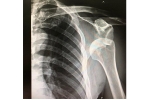What is a Bony Bankart Injury (Shoulder Dislocation)?

A Bony Bankart lesion is a specific type of injury to the shoulder, particularly the glenoid, which is the socket part of the shoulder joint. It occurs when a portion of the bone of the glenoid is fractured along with the detachment of the anterior-inferior labrum due to shoulder dislocation.
Understanding the Anatomy
- Shoulder Joint: Comprises the ball (humeral head) and socket (glenoid).
- Labrum: A ring of cartilage surrounding the glenoid that helps stabilize the shoulder.
- Glenoid: The part of the scapula (shoulder blade) that forms the socket for the humeral head.
Bony Bankart Lesion
-
Mechanism of Injury:
- Often results from a traumatic anterior shoulder dislocation.
- The dislocation forces the humeral head out of the socket, which can cause a fracture of the glenoid rim along with tearing the labrum.
-
Symptoms:
- Recurrent shoulder dislocations.
- Pain and instability in the shoulder, particularly with overhead movements.
- Decreased range of motion and strength.
-
Diagnosis:
- Physical Examination: Tests for shoulder stability and range of motion.
- Imaging: X-rays can show the bony fragment. MRI or CT scans provide detailed views of the bone and soft tissue, confirming the extent of the lesion and associated labral tear.
Treatment Options
Non-Surgical Treatment
- Indications: Minor bony lesions with minimal symptoms or in patients with low physical demands.
- Approach:
- Rest and Activity Modification: Avoid activities that exacerbate symptoms.
- Physical Therapy: Strengthening the rotator cuff and shoulder muscles to improve stability.
- Medications: NSAIDs to manage pain and inflammation.
Surgical Treatment
- Indications: Significant bone loss, recurrent dislocations, high-demand patients, or failure of conservative management.
- Procedures:
- Arthroscopic Repair:
- Minimally invasive surgery using small incisions and a camera (arthroscope).
- The torn labrum is reattached, and the bony fragment is fixed back to the glenoid if possible.
- Open Surgery:
- Larger incision to access the joint directly.
- May be necessary for larger bony fragments or complex cases.
- Latarjet Procedure:
- Transfer of the coracoid process (a part of the scapula) to the front of the glenoid to increase stability.
- Often used when there is significant bone loss or failed previous surgeries.
- Bone Grafting:
- Grafting bone from another part of the body or a donor to reconstruct the glenoid rim.
- Used when there is significant bony deficiency.
- Arthroscopic Repair:
Rehabilitation
-
Post-Surgery:
- Immobilization: Use of a sling for a few weeks to protect the repair.
- Gradual Rehabilitation: Supervised physical therapy focusing on regaining range of motion, followed by strengthening exercises.
-
Return to Activity:
- Gradual return to sports or high-demand activities typically over several months, depending on the extent of the injury and the success of rehabilitation.
Summary
A Bony Bankart lesion is a combination of a bone fracture and a labral tear in the shoulder, typically resulting from traumatic dislocation. Treatment options range from conservative management to surgical repair, depending on the severity of the injury and the patient's activity level. Proper diagnosis and an individualized treatment plan are essential for optimal recovery and prevention of recurrent dislocations. Consulting with an orthopedic specialist can help determine the most appropriate course of action.






